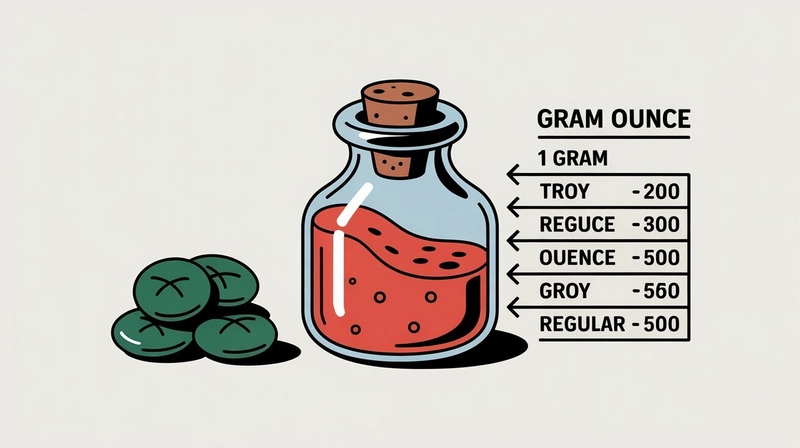Understanding Gold Measurement: Why Converting Grams to Ounces Matters in Investment
Gold has always been seen as a valuable asset. Whether you're a seasoned investor or a curious consumer, understanding how gold is measured is crucial for making informed decisions. When it comes to buying, selling, or investing in gold, one of the most important conversions to know is how many grams are in an ounce of gold. This seemingly simple conversion can have a significant impact on your investment strategies, the way you value gold, and your understanding of the market. For a deeper dive into how many grams are in an ounce of gold and why this matters, check out my detailed article on Truesuggest. In this article, we’ll break down why this conversion is important, how it affects gold pricing, and why having a clear understanding of gold measurements is essential for both investors and consumers alike. Understanding the Gold Measurement System: Gold is primarily measured in troy ounces in the precious metals market, which is different from the standard avoirdupois ounce used for most other commodities. This distinction matters, as a troy ounce is slightly heavier than an avoirdupois ounce—approximately 31.1035 grams, compared to the 28.3495 grams of a regular ounce. Understanding the difference between these two types of ounces is the first step in mastering gold measurement. While the troy ounce is used internationally for trading gold, in most day-to-day transactions, you’ll likely come across grams as a unit of measurement, especially in smaller quantities, such as jewelry and coins. So, knowing how many grams make up a troy ounce is vital for accurate calculations. Gold Measurement in Grams and Ounces: Let’s break it down clearly: 1 troy ounce of gold = 31.1035 grams 1 gram of gold = 0.0321507 troy ounces This conversion is important for several reasons: Investment Accuracy: When you purchase gold, it’s often priced per gram or per ounce. Understanding this conversion allows you to accurately compare prices and make better purchasing decisions, especially in the gold market where precision is key. Market Standardization: International markets rely on the troy ounce for trading, so knowing this conversion helps you stay aligned with global standards. Pricing Flexibility: Whether you're buying jewelry, coins, or bars, the ability to convert grams to ounces (and vice versa) allows you to get a better sense of the value you’re receiving. Why Converting Grams to Ounces is Critical for Gold Investors: Accurate Price Comparison: Understanding the conversion between grams and ounces is essential for comparing gold prices across different platforms, regions, or types of gold. Different sellers may offer pricing in grams, while others might quote in ounces. If you don’t know the conversion, it could lead to overpaying or undervaluing your purchase. Consistency in Gold Trading: Investors often deal in large quantities of gold, such as gold bars, which are typically quoted in troy ounces. For those purchasing smaller amounts, such as jewelry or coins, the gram-based pricing is more common. Knowing how to switch between these two units ensures you’re making informed decisions, whether you're buying or selling. Market Fluctuations: Gold prices are highly volatile and fluctuate daily. Being able to convert between grams and ounces gives you the flexibility to respond to changes in the market quickly and accurately, especially if you’re considering trading gold as a short-term investment. How This Impacts Gold Jewelry Purchases: While most investors look at gold in terms of ounces or grams, consumers buying gold jewelry need to be aware of the gold content in each piece. Jewelry is often priced by weight, but the gold purity must also be taken into account. Gold purity is measured in karats, with 24 karats being pure gold. For example, a 10-gram piece of 18K gold will contain less gold than a 10-gram piece of 24K gold, even though they both weigh the same. Knowing how many grams of gold are in a piece of jewelry—and understanding the price per gram—can help you make better purchasing decisions. Whether you're buying a necklace, ring, or bracelet, understanding the relationship between grams and ounces will ensure you're paying a fair price for the quality of gold you're receiving. The Role of Grams and Ounces in Gold Coins: Gold coins, whether they’re minted for investment or collectible purposes, are often measured by weight, either in grams or ounces. While bullion coins like the American Gold Eagle or the Canadian Gold Maple Leaf are typically measured in troy ounces, other coins may be measured in grams. When you purchase gold coins, you need to pay attention to the weight and purity of the coin. If the coin is measured in grams, you’ll want to convert to troy ounces to get a clearer understanding of its value in the global market. For example: A 1-gram coin of 24K gold might be priced differently than a 1-ounce coin, but knowing how

Gold has always been seen as a valuable asset. Whether you're a seasoned investor or a curious consumer, understanding how gold is measured is crucial for making informed decisions. When it comes to buying, selling, or investing in gold, one of the most important conversions to know is how many grams are in an ounce of gold. This seemingly simple conversion can have a significant impact on your investment strategies, the way you value gold, and your understanding of the market. For a deeper dive into how many grams are in an ounce of gold and why this matters, check out my detailed article on Truesuggest.
In this article, we’ll break down why this conversion is important, how it affects gold pricing, and why having a clear understanding of gold measurements is essential for both investors and consumers alike.
Understanding the Gold Measurement System:
Gold is primarily measured in troy ounces in the precious metals market, which is different from the standard avoirdupois ounce used for most other commodities. This distinction matters, as a troy ounce is slightly heavier than an avoirdupois ounce—approximately 31.1035 grams, compared to the 28.3495 grams of a regular ounce. Understanding the difference between these two types of ounces is the first step in mastering gold measurement.
While the troy ounce is used internationally for trading gold, in most day-to-day transactions, you’ll likely come across grams as a unit of measurement, especially in smaller quantities, such as jewelry and coins. So, knowing how many grams make up a troy ounce is vital for accurate calculations.
Gold Measurement in Grams and Ounces:
Let’s break it down clearly:
1 troy ounce of gold = 31.1035 grams
1 gram of gold = 0.0321507 troy ounces
This conversion is important for several reasons:
Investment Accuracy: When you purchase gold, it’s often priced per gram or per ounce. Understanding this conversion allows you to accurately compare prices and make better purchasing decisions, especially in the gold market where precision is key.
Market Standardization: International markets rely on the troy ounce for trading, so knowing this conversion helps you stay aligned with global standards.
Pricing Flexibility: Whether you're buying jewelry, coins, or bars, the ability to convert grams to ounces (and vice versa) allows you to get a better sense of the value you’re receiving.
Why Converting Grams to Ounces is Critical for Gold Investors:
Accurate Price Comparison: Understanding the conversion between grams and ounces is essential for comparing gold prices across different platforms, regions, or types of gold. Different sellers may offer pricing in grams, while others might quote in ounces. If you don’t know the conversion, it could lead to overpaying or undervaluing your purchase.
Consistency in Gold Trading: Investors often deal in large quantities of gold, such as gold bars, which are typically quoted in troy ounces. For those purchasing smaller amounts, such as jewelry or coins, the gram-based pricing is more common. Knowing how to switch between these two units ensures you’re making informed decisions, whether you're buying or selling.
Market Fluctuations: Gold prices are highly volatile and fluctuate daily. Being able to convert between grams and ounces gives you the flexibility to respond to changes in the market quickly and accurately, especially if you’re considering trading gold as a short-term investment.
How This Impacts Gold Jewelry Purchases:
While most investors look at gold in terms of ounces or grams, consumers buying gold jewelry need to be aware of the gold content in each piece. Jewelry is often priced by weight, but the gold purity must also be taken into account. Gold purity is measured in karats, with 24 karats being pure gold. For example, a 10-gram piece of 18K gold will contain less gold than a 10-gram piece of 24K gold, even though they both weigh the same.
Knowing how many grams of gold are in a piece of jewelry—and understanding the price per gram—can help you make better purchasing decisions. Whether you're buying a necklace, ring, or bracelet, understanding the relationship between grams and ounces will ensure you're paying a fair price for the quality of gold you're receiving.
The Role of Grams and Ounces in Gold Coins:
Gold coins, whether they’re minted for investment or collectible purposes, are often measured by weight, either in grams or ounces. While bullion coins like the American Gold Eagle or the Canadian Gold Maple Leaf are typically measured in troy ounces, other coins may be measured in grams.
When you purchase gold coins, you need to pay attention to the weight and purity of the coin. If the coin is measured in grams, you’ll want to convert to troy ounces to get a clearer understanding of its value in the global market.
For example:
A 1-gram coin of 24K gold might be priced differently than a 1-ounce coin, but knowing how to convert grams to ounces helps you understand the actual value of each coin.
The Impact of Grams to Ounces Conversion on Gold Market Trends:
Understanding how grams convert to ounces also provides insight into market trends. For example, if the price of gold is rising, you may see the price per ounce increase. But if you're purchasing gold by the gram, the impact of market fluctuations might not be as immediately obvious. By being able to convert grams to ounces, you can track gold prices more closely, predict trends, and make more informed decisions.
Gold measurement, particularly the conversion between grams and ounces, plays a crucial role in the world of gold investment and purchasing. Whether you’re an investor looking to make the most of your portfolio, a consumer shopping for jewelry, or someone interested in the precious metals market, having a clear understanding of how grams and ounces relate to each other is vital.
Incorporating this knowledge into your gold buying or selling strategy will not only help you make more informed decisions, but it will also give you an edge in understanding how gold is priced and traded on a global scale. So next time you’re involved in a gold transaction, remember to make those critical conversions—whether it’s grams to ounces or ounces to grams—to ensure you’re getting the best deal possible.










































































































































































![[The AI Show Episode 142]: ChatGPT’s New Image Generator, Studio Ghibli Craze and Backlash, Gemini 2.5, OpenAI Academy, 4o Updates, Vibe Marketing & xAI Acquires X](https://www.marketingaiinstitute.com/hubfs/ep%20142%20cover.png)



























































































































![[DEALS] The Premium Learn to Code Certification Bundle (97% off) & Other Deals Up To 98% Off – Offers End Soon!](https://www.javacodegeeks.com/wp-content/uploads/2012/12/jcg-logo.jpg)


![From drop-out to software architect with Jason Lengstorf [Podcast #167]](https://cdn.hashnode.com/res/hashnode/image/upload/v1743796461357/f3d19cd7-e6f5-4d7c-8bfc-eb974bc8da68.png?#)






































































































.png?#)





.jpg?#)































_Christophe_Coat_Alamy.jpg?#)
 (1).webp?#)





































































































![Rapidus in Talks With Apple as It Accelerates Toward 2nm Chip Production [Report]](https://www.iclarified.com/images/news/96937/96937/96937-640.jpg)








































































































































